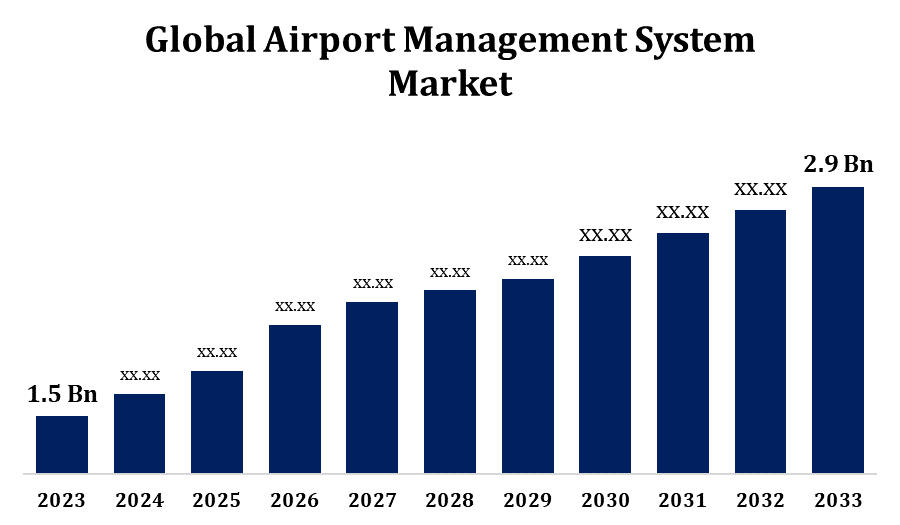Global Airport Management System Market Size, Share, and COVID-19 Impact Analysis, By Component (Software and Services), By Airport Size (Class A, Class B, Class C, Class D) By Application (Security, Content Management, Logistics, Integration, Collaboration, Gate Management, Performance Management, Business Applications And Others), and By Region (North America, Europe, Asia-Pacific, Latin America, Middle East, and Africa), Analysis and Forecast 2023 - 2033
Industry: Aerospace & DefenseGlobal Airport Management System Market Insights Forecasts to 2033
- The Airport Management System Market Size Was valued at USD 1.5 Billion in 2023.
- The Market is growing at a CAGR of 6.81% from 2023 to 2033
- The Worldwide Management System Market is expected to reach USD 2.9 Billion by 2033
- Asia Pacific is expected to grow the fastest during the forecast period

Get more details on this report -
The Global Airport Management System Market Size is expected to reach USD 2.9 billion by 2033, at a CAGR of 6.81% during the forecast period 2023 to 2033.
The Airport Management System (AMS) market is experiencing significant growth due to the increasing demand for efficient airport operations and passenger management. Rising air traffic, airport expansions, and the need for enhanced security and safety measures are driving this market. AMS solutions encompass a wide range of services, including air traffic control, baggage handling, and passenger check-in, streamlining operations and improving the passenger experience. Technological advancements, such as AI, IoT, and cloud computing, are further boosting the adoption of AMS solutions. Additionally, the integration of AMS with existing airport infrastructure is becoming increasingly seamless, reducing operational costs and enhancing efficiency. The market is expected to continue its upward trajectory, driven by global urbanization and the expansion of the aviation sector.
Airport Management System Market Value Chain Analysis
The Airport Management System (AMS) market value chain involves multiple stakeholders, each contributing to the seamless operation and optimization of airport functions. It begins with technology providers who develop software and hardware solutions tailored to airport needs, such as air traffic management, security systems, and passenger services. System integrators play a critical role in implementing these solutions, ensuring they integrate smoothly with existing infrastructure. Airports and airlines, the end-users, utilize AMS to enhance operational efficiency, safety, and customer experience. Regulatory bodies and government agencies also influence the value chain by setting industry standards and compliance requirements. Finally, service providers ensure ongoing maintenance and support, helping airports adapt to evolving technologies and increasing demands. This interconnected value chain is crucial for the continuous improvement of global airport operations.
Airport Management System Market Opportunity Analysis
The Airport Management System (AMS) market presents significant opportunities driven by the global increase in air travel and the expansion of airport infrastructure. With rising passenger volumes, there is a growing need for efficient management systems to enhance operational efficiency, safety, and passenger experience. Emerging markets, particularly in Asia-Pacific and the Middle East, offer substantial growth prospects due to ongoing airport expansions and new airport developments. Additionally, advancements in technologies like AI, IoT, and big data analytics create opportunities for more sophisticated AMS solutions that can predict and respond to operational challenges in real-time. The push towards sustainable aviation and smart airports also opens avenues for innovative AMS offerings that can optimize energy usage and reduce environmental impact, making this a dynamic and expanding market.
Global Airport Management System Market Report Coverage
| Report Coverage | Details |
|---|---|
| Base Year: | 2023 |
| Market Size in 2023: | USD 1.5 Billion |
| Forecast Period: | 2023 - 2033 |
| Forecast Period CAGR 2023 - 2033 : | 6.81% |
| 2033 Value Projection: | USD 2.9 Billion |
| Historical Data for: | 2019 - 2022 |
| No. of Pages: | 225 |
| Tables, Charts & Figures: | 120 |
| Segments covered: | By Component, By Airport Size, By Application, By Region |
| Companies covered:: | Microsoft Corporation, Blip System, Huawei, isco, SAP SE, Amadeus IT Group (Spain), QinetiQ, Amadeus IT Group, SITA, Rockwell Collins, Inc, Inform GmbH. |
| Pitfalls & Challenges: | COVID-19 Empact, Challenge, Future, Growth, & Analysis |
Get more details on this report -
Market Dynamics
Airport Management System Market Dynamics
Growing Need for Cloud-Based Solutions
As airports face increasing pressure to manage rising passenger volumes and complex operations efficiently, cloud-based AMS solutions offer scalability, flexibility, and cost-effectiveness. These solutions enable real-time data sharing and collaboration across multiple stakeholders, including airlines, ground services, and regulatory bodies, enhancing operational coordination and decision-making. Additionally, cloud-based systems support advanced analytics and AI-driven insights, allowing airports to optimize resource allocation, improve passenger flow, and enhance security measures. With the ability to update and maintain systems remotely, cloud solutions reduce the need for on-site IT infrastructure, lowering operational costs and minimizing downtime. This shift towards cloud adoption is expected to accelerate, driving significant growth in the AMS market.
Restraints & Challenges
One significant challenge is the high initial cost of implementation, which can be a barrier for smaller airports or those in developing regions. Integrating AMS solutions with legacy systems poses technical difficulties, often requiring extensive customization and skilled personnel. Additionally, the complexity of coordinating multiple stakeholders—airlines, regulatory bodies, and service providers—can complicate system deployment and operation. Cybersecurity is another critical concern, as airports are increasingly targeted by cyber-attacks, necessitating robust security measures to protect sensitive data and ensure operational continuity. Furthermore, the need for compliance with stringent aviation regulations and standards adds to the complexity and cost of AMS implementation. These challenges require careful planning and innovative solutions to fully realize the benefits of AMS technologies.
Regional Forecasts
North America Market Statistics

Get more details on this report -
North America is anticipated to dominate the Airport Management System Market from 2023 to 2033. The U.S. and Canada are at the forefront, with major airports investing in advanced AMS solutions to enhance operational efficiency, security, and passenger experience. The demand for cloud-based and AI-driven systems is rising, as these technologies enable real-time decision-making and predictive analytics. Additionally, the push towards modernization, including the development of smart airports, is fueling the adoption of integrated AMS platforms. Regulatory requirements for safety and security are also driving investments in cutting-edge technologies. However, challenges such as high implementation costs and the need for seamless integration with existing systems persist, necessitating innovative approaches to maintain market growth in this region.
Asia Pacific Market Statistics
Asia Pacific is witnessing the fastest market growth between 2023 to 2033. Emerging nations are heavily investing in airport infrastructure to accommodate rising demand. New airport constructions and the modernization of existing facilities are fueling the adoption of advanced AMS solutions, particularly those utilizing AI, IoT, and cloud technologies. The region's focus on developing smart airports is further accelerating the integration of comprehensive AMS platforms that enhance operational efficiency, safety, and passenger experience. However, challenges such as varying regulatory environments, integration with legacy systems, and high implementation costs remain. Despite these hurdles, the Asia-Pacific region presents immense growth opportunities as it continues to lead global aviation expansion.
Segmentation Analysis
Insights by Component
The software segment accounted for the largest market share over the forecast period 2023 to 2033. As airports handle growing passenger volumes and complex logistics, software solutions that streamline operations such as air traffic management, passenger processing, and resource allocation are in high demand. The shift towards cloud-based platforms, AI, and big data analytics is further propelling this segment, enabling real-time decision-making and predictive maintenance. Additionally, software solutions offer scalability and flexibility, allowing airports to adapt to changing demands without significant infrastructure overhauls. The push for smart airport initiatives and the adoption of Internet of Things (IoT) technologies are also contributing to the expansion of the software segment, making it a critical component of modern AMS offerings.
Insights by Airport Size
The Class C segment accounted for the largest market share over the forecast period 2023 to 2033. As air travel expands beyond major hubs, these smaller airports are increasingly adopting AMS solutions to improve operational efficiency, safety, and passenger experience. The growing need for cost-effective and scalable solutions is driving the demand for cloud-based and modular AMS software, which offers advanced capabilities without the high costs associated with larger airports. Additionally, government initiatives to improve regional connectivity and enhance airport infrastructure are fueling investments in AMS for Class C airports. Despite budget constraints, these airports are recognizing the value of automation and digitalization, making the Class C segment a key growth area in the AMS market as regional air travel continues to rise.
Insights by Application
The security segment accounted for the largest market share over the forecast period 2023 to 2033. As airports strive to enhance their security protocols, investments in advanced AMS solutions are rising, including biometric systems, automated threat detection, and surveillance technologies. The integration of AI and machine learning into security systems enables real-time monitoring and rapid response to potential security breaches. Additionally, the demand for compliance with stringent international security regulations is driving the adoption of comprehensive security solutions. As global air travel grows and threats become more sophisticated, the emphasis on robust security measures in AMS solutions is expected to continue driving growth in this segment, ensuring safer and more secure airport operations.
Recent Market Developments
- In July 2023, Zagreb Airport in Croatia has announced the implementation of new IT solutions developed by TAV Technologies. These advancements are aimed at enhancing the passenger experience and boosting operational efficiency.
Competitive Landscape
Major players in the market
- Microsoft Corporation
- Blip System
- Huawei
- isco
- SAP SE
- Amadeus IT Group (Spain)
- QinetiQ
- Amadeus IT Group
- SITA
- Rockwell Collins, Inc
- Inform GmbH.
Market Segmentation
This study forecasts revenue at global, regional, and country levels from 2023 to 2033.
Airport Management System Market, Component Analysis
- Software
- Services
Airport Management System Market, Airport Size Analysis
- Class A
- Class B
- Class C
- Class D
Airport Management System Market, Application Analysis
- Security
- Content Management
- Logistics
- Integration
- Collaboration
- Gate Management
- Performance Management
- Business Applications
- Others
Airport Management System Market, Regional Analysis
- North America
- US
- Canada
- Mexico
- Europe
- Germany
- Uk
- France
- Italy
- Spain
- Russia
- Rest of Europe
- Asia Pacific
- China
- Japan
- India
- South Korea
- Australia
- Rest of Asia Pacific
- South America
- Brazil
- Argentina
- Rest of South America
- Middle East & Africa
- UAE
- Saudi Arabia
- Qatar
- South Africa
- Rest of the Middle East & Africa
Frequently Asked Questions (FAQ)
-
1. What is the market size of the Airport Management System Market?The Global Airport Management System Market is expected to grow from USD 1.5 billion in 2023 to USD 2.9 billion by 2033, at a CAGR of 6.81% during the forecast period 2023-2033.
-
2. Who are the key market players of the Airport Management System Market?Some of the key market players of the market are Microsoft Corporation (US), Blip System (Denmark), Huawei (China), isco (US), SAP SE (Germany), Amadeus IT Group (Spain), QinetiQ, Amadeus IT Group, SITA, Rockwell Collins, Inc, Inform GmbH.
-
3. Which segment holds the largest market share?The software segment holds the largest market share and is going to continue its dominance.
-
4. Which region dominates the Airport Management System Market?North America dominates the Airport Management System Market and has the highest market share.
Need help to buy this report?